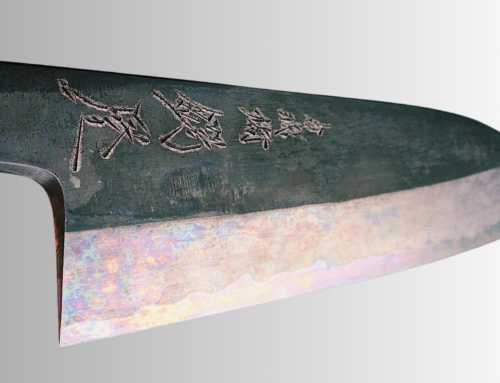There are many types of Japanese knives, each with a specific purpose and design. Some of the most common types include:
- Bunka: It’s a versatile knife that is similar in shape and function to a Western chef’s knife, and it’s designed for chopping, slicing, and dicing a wide variety of ingredients including meats, fish, vegetables and fruits.
- Deba: A heavy, thick-bladed knife that is commonly used for cutting fish and meats. It’s typically used for filleting and butchering, and it’s also known as “Deba-bocho”.
- Gyuto: A versatile chef’s knife that is similar in shape and function to the Western chef’s knife. It is commonly used for slicing, dicing, and chopping.
- Honesuki: A knife used for breaking down poultry, it’s a heavy and strong knife for separating joints and bones, it’s also known as “Honesuki-bocho”
- Yanagiba: A long and narrow knife that is used for slicing raw fish, it’s typically used for sushi and sashimi. It’s also known as “Yanagiba-bocho”. Takohiki is a knife similar to Yanagiba that is used for slicing raw fish, it’s typically used for sushi and sashimi, but it has a square tip and a thicker blade.
- Kiritsuke: A versatile knife that is similar in shape and function to the Gyuto, but it has a longer and flatter tip. It’s typically used for slicing, dicing, and chopping, but it’s also used for fish preparation and slicing.
- Nakiri: A knife specifically designed for cutting vegetables. It has a straight edge and a square tip, and is commonly used for chopping, slicing, and dicing vegetables. Usuba it’s similar in shape and function to the Nakiri, but it has a thinner blade and is generally harder to use and sharpen.
- Petty (Utility): A knife commonly used by professional chefs, home cooks, and culinary students as a secondary or back-up knife. It is a versatile option to have in a kitchen, since it is small enough to maneuver easily and can be used for a wide range of tasks.
- Santoku: A versatile knife that is similar in shape and function to the Western chef’s knife. It is commonly used for chopping, slicing, and dicing vegetables, fruits, and meats.
- Sujihiki: A knife that is similar in shape and function to the Western carving knife and slicer. It’s used for slicing, carving and filleting meats, fish, and poultry.
Each type of knife is designed to perform specific tasks and is made from different types of steel and with different handle materials.

BUNKA
A bunka knife is a type of Japanese kitchen knife that is similar to a Western chef’s knife. It is a versatile knife that can be used for a variety of tasks in the kitchen, such as chopping, slicing, and dicing. Bunka knives typically have a curved blade and a pointed tip, which makes them well-suited for tasks such as mincing herbs and garlic, and cutting vegetables and meats. They are also commonly used for slicing fish. The word “bunka” in Japanese means “culture” or “civilization”, the knife design is a fusion of Western and Japanese knife making, taking the best of both worlds. They are generally made of high-quality steel and are sharpened to a very fine edge.

DEBA
A Deba knife is a type of Japanese kitchen knife that is used for butchering fish and poultry. The name “deba” means “point” and refers to the knife’s pointed tip that is used for making precise cuts. It’s typically between 150-240mm long, with a thick and heavy blade that allows it to handle heavy-duty tasks such as filleting fish, chopping through fish bones, and breaking down poultry.
The deba knife has a single-beveled edge, which is sharpened at a steeper angle than double-beveled knives. This design allows for a sharp and precise edge that can easily separate meat from bones. The blade’s thickness also allows it to chop through bones and fish heads without getting damaged.
Deba knives are typically used by professional fishmongers and sushi chefs, but it’s also a great tool for home cooks who frequently prepare fish and poultry. It’s commonly used in Japan and other parts of Asia.
When using a deba knife, it’s important to use proper cutting techniques and to keep the blade sharp to ensure safety and precision. The handle of the knife is usually made of wood, plastic, or composite materials and it’s usually shaped to fit comfortably in the user’s hand. The Deba knife is also called “Deba-bocho” in Japanese, and is one of the most essential knives in a Japanese kitchen.

GYUTO
A Gyuto knife is a type of Japanese kitchen knife that is similar to a Western chef’s knife. The name “Gyuto” is derived from the Japanese word for “beef sword,” and the knife is primarily used for slicing and chopping meats, but it can also be used for a variety of tasks in the kitchen, such as chopping, slicing, and dicing fruits, vegetables and fish. Gyuto knives typically have a curved blade that tapers to a sharp point, which makes them well-suited for tasks such as mincing herbs, slicing and cutting vegetables, and meats. They are also commonly used for slicing fish and filleting. They are generally made of high-quality steel, the most common of which is VG-10 steel, and are sharpened to a very fine edge. They are commonly used by professional chefs and home cooks who are looking for a high-performance knife that can handle a variety of tasks.

HONESUKI
A Honesuki knife is a type of Japanese kitchen knife that is used for breaking down poultry and other meats. It’s a pointed, heavy-duty knife that is typically between 120-180mm long, and has a thick, triangular-shaped blade that is designed for precision cuts and chopping through bones.
The Honesuki knife is a single-beveled knife, which means that only one side of the blade is sharpened, this makes it ideal for cutting through bones and other tough meats. The pointed tip of the knife is also useful for separating meat from bones, and for making precise cuts.
It’s commonly used by professional chefs and home cooks in Japan, and it’s an essential tool for breaking down poultry, game birds, and other meats. Honesuki knives are also used for other tasks such as cutting meat, fish and vegetables.
Honesuki knives are usually made from high-quality steel and are sharpened to a very fine edge. The handle of the knife is usually made of wood, plastic, or composite materials and it’s usually shaped to fit comfortably in the user’s hand. The Honesuki knife is also called “Honesuki-bocho” in Japanese, and is one of the most essential knives in a Japanese kitchen.

KIRITSUKE
A kiritsuke knife is a type of Japanese kitchen knife that is known as a “kiritsuke-bocho” in Japanese. The word “kiritsuke” refers to the style of the knife, which is a combination of a traditional Japanese usuba knife and a Western chef’s knife. The knife is a hybrid knife, which is a cross between a traditional Japanese usuba and a western chef knife. It has a long, straight edge like a chef’s knife, but also has a square tip like a usuba, which allows for easy chopping and slicing. The blade is typically longer than the Usuba knife and shorter than the Gyuto knife, typically between 210-240mm. It’s a versatile knife that can be used for a variety of tasks in the kitchen, such as chopping, slicing, and dicing vegetables, fruits and meats. It’s also commonly used for fish preparation and slicing. Kiritsuke knives are generally made of high-quality steel and are sharpened to a very fine edge. They are usually used by professional chefs and home cooks who are looking for a versatile knife that can handle a variety of tasks. It’s worth noting that Kiritsuke knives are traditionally used only by head chefs in Japan, because they are considered to be difficult to use and sharpen, and typically only highly skilled chefs are trained to use them.

NAKIRI
A nakiri knife is a type of Japanese kitchen knife that is known as a “nakiri-bocho” in Japanese. The name “nakiri” means “vegetable knife.” It’s a traditional Japanese knife that is specifically designed for cutting vegetables. The knife has a straight edge, which allows for precise cuts, and a square tip which allows for easy chopping. The blade is typically thin and the knife has a flat edge that runs straight to the tip, it’s typically between 150-180mm long. It’s a versatile knife that can be used for a variety of tasks in the kitchen, such as chopping, slicing, and dicing vegetables, fruits and meats. It’s also commonly used for fish preparation and slicing. Nakiri knives are generally made of high-quality steel and are sharpened to a very fine edge. They are commonly used by professional chefs and home cooks who are looking for a knife that can handle a variety of tasks, specifically for vegetable preparation. It’s worth noting that Nakiri knives are similar in shape and function to the Usuba knives, but have a slightly thicker blade and are generally easier to use and sharpen than Usuba knives.

PETTY (UTILITY)
A petty knife, also known as a utility knife, is a small, multi-purpose kitchen knife that is used for a variety of tasks. It’s typically between 120-150mm long and has a narrow, pointed blade that is useful for precision cutting and trimming tasks. It is a versatile knife that can be used for peeling, slicing, and trimming fruits and vegetables, as well as for small cutting tasks such as mincing herbs, slicing small fruits and vegetables, and cutting small pieces of meat. Petty knives are commonly used by professional chefs, home cooks, and culinary students as a secondary or back-up knife. It is a versatile option to have in a kitchen, since it is small enough to maneuver easily and can be used for a wide range of tasks.
The design of petty knives can vary, some have a straight edge, others have a curved edge, and some are made with different types of steel. The handle can be made of different materials, such as wood, plastic, or composite materials.
It’s a great addition to any kitchen, it can also be used for outdoor activities such as camping, hunting or fishing. In Japan, the petty knife is called “Petty-bocho” and it’s widely used by home cooks and professionals. It’s a must-have knife for a well-rounded knife set.

SANTOKU
A santoku knife is a type of Japanese kitchen knife that is known as a “santoku-bocho” in Japanese. The name “santoku” means “three virtues” or “three uses” and refers to the knife’s ability to handle three different tasks: slicing, dicing, and mincing.
It’s a versatile knife that can be used for a variety of tasks in the kitchen, such as chopping, slicing, and dicing vegetables, fruits and meats. The knife has a short, broad blade, typically between 130-180mm long, with a straight edge that tapers to a sharp point. The edge is typically beveled on both sides, which allows for easy slicing and chopping.
It’s a versatile knife that can be used for a variety of tasks in the kitchen, such as chopping, slicing, and dicing vegetables, fruits and meats. It’s also commonly used for fish preparation and slicing. Santoku knives are generally made of high-quality steel and are sharpened to a very fine edge. They are commonly used by professional chefs and home cooks who are looking for a versatile knife that can handle a variety of tasks.
It’s worth noting that Santoku knives are similar in shape and function to the Western chef’s knives and are often used as an alternative to a chef’s knife.

SUJIHIKI
A sujihiki knife is a type of Japanese kitchen knife that is known as a “sujihiki-bocho” in Japanese. The name “sujihiki” means “to slice meat” and refers to the knife’s ability to handle slicing tasks, particularly for slicing raw fish, meat and poultry.
It’s a double-beveled knife with a thin, long, and narrow blade, typically between 240-300mm long, that is ideal for slicing, carving, and filleting tasks. The long and narrow blade of sujihiki knife allows for precise and smooth slicing and is perfect for slicing delicate meats and fish, such as sashimi or carpaccio.
It’s a versatile knife that can be used for a variety of tasks in the kitchen, such as slicing, carving, and filleting meats, fish, and poultry. Sujihiki knives are generally made of high-quality steel and are sharpened to a very fine edge. They are commonly used by professional chefs and home cooks who are looking for a versatile knife that can handle a variety of tasks, specifically for slicing meats and fish.
It’s worth noting that Sujihiki knives are similar in shape and function to the Western carving knife and slicer.


